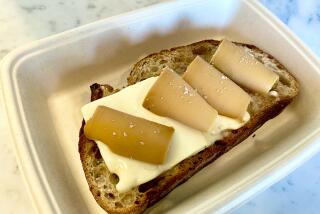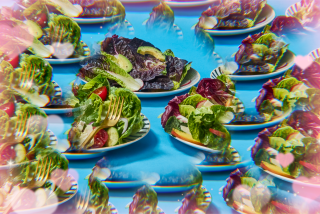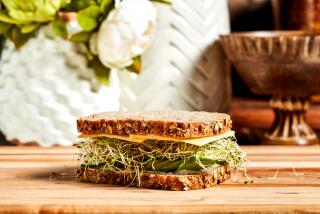Benefits of Fruits, Vegetables Still Go Unrealized
- Share via
Californians are drinking more orange juice and eating more green salad than they were a year ago. But they’re still not eating enough fruits and vegetables, according to a recent Department of Health Services poll. Only one-fourth of those polled think they should eat five or more servings of produce each day, and about a third actually do.
That means a lot of people in the state are missing the opportunity to take charge of their health and reduce risk for cancer and other health problems related to diet, said Susan Foerster, a registered dietitian and chief of the Nutrition and Cancer Prevention Program, which conducted the California Dietary Practices Survey.
“Overall, only one out of three Californians eats the amount we recommend every day,” Foerster said. “More Californians need to know about the importance of ‘5 a Day.’ ”
The National Cancer Institute estimates that 35% of all cancer deaths in the United States--including lung, breast, colon and rectum, prostate and bladder cancers--can be traced to poor diet habits. As a result, the National Academy of Sciences, the U.S. Department of Agriculture, the American Cancer Society and the Health Services Department all have increased their recommendation from four servings of fruits and vegetables a day to five. (One serving is equivalent to one whole piece of fruit or one-half cup of cut-up fruit, one-half cup cooked vegetable, one cup leafy greens or 1/4 cup dried fruit.)
All these groups recommend eating cruciferous vegetables such as cabbage and broccoli, Vitamin A-rich fruits and vegetables (those that are dark green or yellow-orange), and those high in Vitamin C. Yet a mere 7% of those asked in the survey said they ate broccoli. Only 9% consume cantaloupe and 10% eat oranges.
“The survey shows that for one Californian in 10, salad is the only fruit or vegetable that they eat all day,” Foerster complained, even though the poll was taken during the summer months, when fresh fruits and vegetables are the least expensive and most plentiful. And for these people, she added, the salads usually include little more than the basic greens--specifically, lettuce.
In the poll of 1,000 people surveyed in telephone interviews last May to September, green salad and orange juice were the fruits and vegetables most likely to be eaten on a given day. About 30% of the people reported eating these items.
About 27% said they didn’t eat any vegetables at all on the day of the survey; 20% said they didn’t eat any fruit even though fresh, frozen, canned and dried fruit, as well as fruit and vegetable juices, potatoes and salad were allowable items in the survey.
Confusion about diet and health advice may be one factor for the low figures. Foerster said that many people feel helpless in the fight against cancer. They contend that there are so many uncontrollable environmental factors--pesticide residues and pollution--that what they can do for themselves won’t make that much difference.
Additionally, the majority of the respondents explained that “there are so many recommendations about what’s good and bad to eat that it’s hard to know what to believe.” More than half couldn’t name a food that might prevent cancer; about 40% stated they don’t think that food can influence development of the disease.
“But the evidence is exactly the opposite,” Foerster reported. She said that population studies and clinical trials both show a strong relationship between fruit and vegetable consumption and cancer development, and she said the link is “getting stronger.”
She explained that it’s easy to increase the amount of fruits and vegetables in the daily diet, and cost need not be an issue. By serving seasonal fresh fruits for dessert you can cut down the amount of sugary, fat-laden after-meal treats eaten each day. Using fresh fruits and vegetables during their peak season is a way to cut down on cost. A fruit salad of melon balls, nectarine, peach and plum slices, grapes and other fruits, for example, dressed with a low-fat lemon or vanilla yogurt dressing is inexpensive--and delicious. If cost is not a factor, exotic fruits such as kiwi can be tossed into salads or used to lace frozen desserts.
When salad is the vegetable of choice, be sure to limit high-fat ingredients and toppings such as dressings, mayonnaise, oils, olives, cheese and bacon. Dark-green leafy vegetables such as spinach, beans, broccoli, carrots and cabbage, which are prized for their vitamin and fiber content, should be maximized as fixings. At the salad bar, avoid chopped egg, croutons, fried noodles, avocado and creamy deli salads such as macaroni and potato salad and coleslaw. Ask for dressing on the side and substitute bread sticks or Melba toast for garlic bread.
Following are three menus that feature summer fruits, now at the peak of the season. Blueberries and nectarines are featured in a light breakfast shake that is ideal for hectic mornings. Since salads are popular this time of year, they are included both at lunch and dinner. A Baked Banana and Peach Dessert rounds out the selections.
FIRST DAY
BREAKFAST
Blueberry-Nectarine Breakfast Shake
Bran muffin
1 teaspoon margarine
LUNCH
Tuna Salad:
3 ounces tuna packed in water
1/2 large red apple, diced
2 stalks celery, diced
1 tablespoon reduced-calorie mayonnaise
2 slices whole-wheat bread
Sliced tomato
Lettuce leaves
1 cup low-fat milk
DINNER
2 to 3 ounces lean roast beef
Mashed potatoes
Vegetable Marinade Salad
Steamed Brussels sprouts
Whole-wheat dinner roll
1 cup low-fat milk
SNACK
Fresh fruit salad
SECOND DAY
BREAKFAST
2/3 cup shredded wheat cereal
1 cup low-fat milk
1/2 ca ntaloupe
1 slice whole-wheat toast
1/2 cup orange juice
LUNCH
Sunshine Salad
Skim milk cottage cheese
Rye crackers
DINNER
Broiled swordfish steak or other firm-fleshed fish
Baked potato
Green salad
Whole-wheat dinner roll
SNACK
Baked Banana and Peach Dessert
THIRD DAY
BREAKFAST
2 blueberry or strawberry pancakes
2 tablespoons pancake syrup
1 teaspoon reduced - calorie margarine
1 cup low - fat milk
LUNCH
Broccoli Quiche Squares
Green salad
Slice crusty bread
Peach
DINNER
3 ounces baked chicken
1/2 cup cooked pasta or rice
1/2 cup steamed spinach
1/2 cup steamed carrots
Whole-wheat roll
SNACK
Frozen yogurt with berries
BLUEBERRY-NECTARINE BREAKFAST SHAKE
2 1/4 cups blueberries
2 nectarines, chopped
2 frozen bananas, sliced
2 tablespoons wheat germ
1/4 cup orange juice
Puree blueberries, nectarines, bananas, wheat germ and orange juice in blender until smooth. Serve over crushed ice, if desired. Makes 3 large servings.
VEGETABLE MARINADE SALAD
2 cups broccoli pieces
1 1/2 cups diced tomatoes
1 (4-ounce) can button mushrooms, drained
1 (4-ounce) can artichoke hearts, drained
1/8 cup flavored vinegar
3 tablespoons reduced-calorie Italian dressing
Add 2 to 3 tablespoons water to broccoli in microwave-safe dish and cover with plastic wrap, venting corner. Microwave 3 minutes on HIGH or until tender. Drain and rinse under cool water. Drain again.
Toss with tomatoes, mushrooms, artichoke hearts in large bowl. Mix vinegar and dressing and pour over all. Refrigerate until ready to serve. Makes 5 servings.
SUNSHINE SALAD
4 cups fresh spinach leaves, torn
2 nectarines, sliced
1 cup fresh strawberries, halved
6 tablespoons reduced-calorie vinaigrette
1 tablespoon sunflower seeds, dry roasted
Toss together spinach, nectarine slices, strawberries and vinaigrette. Sprinkle sunflower seeds over top. Makes 4 servings.
BAKED BANANA AND PEACH DESSERT
2 peaches, sliced or chopped
1/2 teaspoon vanilla
1 teaspoon sugar
2 bananas, cut into halves
Puree peach slices in blender or food processor.
Mix puree, vanilla and sugar in small saucepan. Bring to boil, then reduce heat and simmer covered 1 minute, stirring occasionally.
Place banana halves on individual squares foil. Top with 2 tablespoons peach sauce. Fold foil and place on baking sheet. Bake at 400 degrees 15 minutes. Serve immediately. Makes 4 servings.
BROCCOLI QUICHE SQUARES
1 pound broccoli
1/4 cup flour
1/2 cup egg substitute or 2 whole eggs
1/2 cup shredded part-skim mozzarella cheese
1/4 cup chopped parsley
1/2 teaspoon dried oregano
1/2 teaspoon dried basil
1 cup low-fat cottage cheese
1 cup part-skim ricotta cheese
1 tablespoon lemon juice
1/2 teaspoon salt
1/4 teaspoon black pepper
1/4 cup fresh bread crumbs
Steam broccoli until barely tender, then chop into small pieces.
Beat flour and egg substitute until well blended. Add broccoli, mozzarella, parsley, oregano, basil, cottage and ricotta cheeses, lemon juice, salt and pepper. Mix gently.
Spray 9-inch square baking pan with non-stick vegetable spray. Pour in egg mixture, then sprinkle bread crumbs over top. Bake at 350 degrees 35 to 40 minutes. Cool slightly and cut into squares. Makes 9 servings.
More to Read
Sign up for Essential California
The most important California stories and recommendations in your inbox every morning.
You may occasionally receive promotional content from the Los Angeles Times.













